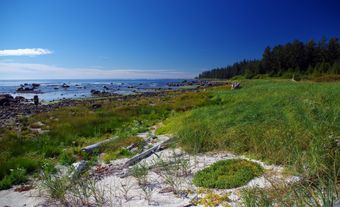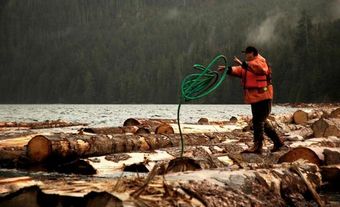Territory and Population
(courtesy Native Land Digital / Native-Land.ca)
In the late 18th century, the people now known as Ditidaht (“Nitinat”) were a loose alliance of a number of autonomous local groups living along the west coast of Vancouver Island. Warfare and disease resulted in greater unity among the surviving local groups as villages were raided, people were killed and some groups became extinct. Change in territories took place as groups disappeared or amalgamated with others in the 20th century.
The local groups comprising the Ditidaht consisted of a number of people occupying a specific geographical area and centred around chiefs and their families. Each group was designated by the name of its main village’s location, scattered along the west coast of Vancouver Island between Bonilla Point and Pachena Point, inland along Nitinat Lake and eastward to include Cowichan Lake — the area the Ditidaht still call home. In 1890, 17 Ditidaht villages and seasonal camps were designated as reserves.
At present, the main permanently occupied Ditidaht village is situated in Malachan, a settlement that lies at the head of Nitinat Lake. Ditidaht people are also located in surrounding towns and cities. Prior to the mid-1960s, Ditidaht people occupied several villages along the open coast, but many Ditidaht moved to Malachan in order to have greater access to services.
As of October 2021, the federal government counts 775 registered members of the Ditidaht nation.
Traditional Life and Society
The Ditidaht were historically a fishing community. They fished for salmon, halibut and other local fish species, and hunted and foraged for other foods to supplement their diet. Like other Nuu-chah-nulth nations, the Ditidaht travelled by canoe and on foot to get to and from hunting and fishing sites.
The chiefs who governed Ditidaht society (known as chaabat) held rights to the fish and other food resources found on their territory. Poaching and intruding on private property could result in death.
Culture
In Ditidaht culture, families hold the rights to intangible property, called tupaat, which includes stories, songs, dances and other cultural practices. Tupaat is passed down through family lineages and is still presented at potlatches.
Language
The Ditidaht speak Nitinaht or Ditidaht, which is considered distinct from the Nuu-chah-nulth language, Nuučaan̓uɫ. The Ditidaht language is closely related to that of the Makah, who live across the Juan de Fuca Strait, and the Pacheedaht, who occupy territory southeast of the Ditidaht. Ditidaht is part of the Wakashan language group. The language is severely endangered, with only a handful of fluent speakers. (See also Indigenous Languages in Canada.)
Religion and Spirituality

The Ditidaht have stories and legends that speak of their past and are used to pass on traditional knowledge to future generations. Most creation stories speak of the Creator who made the lands, waters, creatures and people. Ditidaht stories also tend to feature important cultural figures such as Raven, a trickster figure who helps the people to adapt to their surroundings. (
See alsoRaven Symbolism and Indigenous People: Religion and Spirituality.)
Colonial History
The Ditidaht made contact with European traders in the late 1700s. Increased European settlement in Ditidaht traditional territories meant significant changes to the daily life of the Ditidaht. Forced onto reserves, the Ditidaht were also made to assimilate to white, Christian, Canadian culture through federal programs and policies such as residential schools. Ditidaht culture has survived in spite of these dark moments in Canadian history.
Contemporary Life

Since the 1990s, the Ditidaht, Huu-ay-aht (Ohiaht) and Pacheedaht First Nations have worked with Parks Canada to provide long-term employment opportunities for Indigenous people in the maintenance, interpretation and marketing of the Westcoast Trail within Pacific Rim National Park. Campgrounds on Ditidaht reserves constitute part of the trail facilities. Ditidaht-owned businesses in Malachan, including a motel, a store and a gas station also service tourists in the area. A salmon hatchery, logging, commercial fishing and crabbing provide other employment. Co-management of resources through partnerships with governmental and other organisations within Ditidaht territory is a long-term objective.
The Ditidaht are also part of the Nuu-chah-nulth Tribal Council (previously known as the West Coast Allied Tribes), an association founded in 1958 that provides various services to approximately 9,500 registered members, including child welfare, education, employment training and other socio-economic programs that support health and development.
In 2013, the Ditidaht and Pacheedaht First Nations signed agreements with British Columbia that will bring economic benefits to the two communities’ members and to southwest Vancouver Island. The signings are a significant step forward in a six stage treaty process aimed at self-government, monetary and land resources and the acknowledgment of Indigenous rights and title to territory. The Ditidaht are currently in stage four of this process.

 Share on Facebook
Share on Facebook Share on X
Share on X Share by Email
Share by Email Share on Google Classroom
Share on Google Classroom




